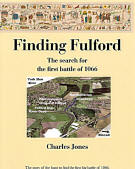All History Guide: Your guide to history on the Internet..
" .. this unusual, and yes, excellent history book.."
"More books like this one introducing historical study in a sympathetic was are needed.."
Now in paperback
... and into its 3rd reprint!
6. The impact of the proposed development on the Battlefield
6.1. The proposed access road to the development will permanently destroy the visual integrity of the battlefield. The planners have failed to require the developers to provide suitable visualisation as has already been noted when discussing the errors and omissions of the planners.
- 6.1.1. The call-in letter from ODPM asks if the development ‘will harm the
visual amenities of the green belt’. While F i) of the same letter asks if PPS7
guidelines on siting, location and accessibility principle followed. PPS 22
suggests that an objective analysis is carried out:
- 6.1.1.1. Para 5.14 of PPS22 states that landscape and visual effects should be assessed on a case by case basis. It also states that “proposed developments should be assessed using objective descriptive material and analysis wherever possible” (para 19). This section describes a number of common approaches to landscape and visual assessment that may assist local planning authorities in this task. (PPS 22 guidelines) This analysis is lacking.
- 6.1.1.2. Requests have been made in writing and verbally during the site visit with the developers and city councillors, at the planning meeting itself and during the pre-inquiry meeting that a three-dimensional model should be provided to allow the visual impact of the proposed development to be assessed.
- 6.1.1.3. The same guidance (5.20 ff) gives some very specific examples of the range of visual material required to allow the public as well as the planners to assess the impact.
- 6.1.1.4. In particular, the impact that the route of the road will have on the
visual amenity of
- 6.1.1.4.1. those living there,
- 6.1.1.4.2. people approaching on the A19 and
- 6.1.1.4.3. those using the surviving green spaces of Walmgate Stray or Heslington Common
- 6.1.1.4.4. and those using the golf course
- have nowhere been addressed.
6.2. The city archaeologist lists three criteria for assessing the impact of the proposed development: (2.1)
· The landscape of the battle,
· The amount of change that has taken place and
· How much the development might be prejudiced.
6.2.1. The outline of a wall might indicate a castle or abbey. However a battlefield needs to arrest the imagination so the troops can be imagined fighting across the landscape or the line of the shield wall inspected. The modern landscape in which the battle is set is therefore very important. This site is remarkable. Because it is so well preserved, and enjoys so much public access, two major re-enactments have been undertaken and three short films have been shot on the site.
6.2.2. Reconstruction of the 1066 landscape was at the core of the investigation work. The landscape as it stands therefore does fulfil the function of a place to allow the battle to be understood.
6.2.3. Moving on to last of the test applied by the City Archaeologist, the development proposed would destroy any chance that visitors would be able to envisage the landscape of 1066. The proposed access road implies the complete destruction of the battlesite.
6.3. PPG13 sets out advice to be followed when planning the transport for a development. It sets out these principles:
- 6.3.1. “By shaping the pattern of development and influencing the location, scale, density, design and mix of land uses, planning can help to reduce the need to travel, reduce the length of journeys and make it safer and easier for people to access jobs, shopping, leisure facilities and services by public transport, walking, and cycling. Consistent application of these planning policies will help to reduce some of the need for car journeys and enable people to make sustainable transport choices.”
- 6.3.2. How a site, with a single access, that enters the development at one edge can be deemed to be reducing journey times and traffic is hard to understand. Every journey has to add two transits along the access road. The proposed disposition of shopping near this road will not only entice others to drive into the development but is far enough from the ‘centre of accommodation’ that it is likely to require people to use their cars inside the estate as reported by CABE in the Consett study.
- 6.3.3. The road is as misplaced as it could possibly be for the adjacent proposed development at the York University. On 30 April 2005 the city’s traffic officer asked the developer to comment on combined impact with university. However, the University developers refuse to cooperate so no impact assessed. It would be unwise to proceed until the impact on the traffic flow can be assessed. This is too much, too fast.
- 6.3.4. It was also suggested the PICARDY and LINSIG software be used to assess traffic impact but the results of that are unknown. Even the Highways Agency have not been able to help to assess the impact that the traffic will have because it is not their ‘policy to consider tentative planning applications in Transport Assessments until such time that the application s have been approved’. The net effect is that we really do not have any model of how the proposed access will impact the area. This is not acceptable.
- 6.3.5. Finally, the bus companies have declined to run busses to the estate because the access does not allow them to be fitted into any sensible bus routing. The provision of a short-term subsidy from the developer was the ridiculous solution accepted by the planning committee.
- 6.3.6. The developers will have completed the development when their transport subsidy expires, leaving the problem with the Council. At that stage they will probably have to provide further access routes for public transport but what is far more likely, the site will by then have developed as a ‘car-only’ estate where every resident will require a car just as at Persimmon’s estate in Consett.
- 6.3.7. The access route breaches the key principles set out in the planning guidance. If proper access was provided at the eastern end of the development, it would give speedy access to the university. A series of small-scale developments that linked to the existing access roads is another solution but one that will require negotiation with those affected. This solution to road-access would oblige the planners and the developers to meet and address the needs of the local people.
6.4. The real fear for the battlefield that if the disastrous route along Germany Beck was approved, further developments would be needed to cope with the traffic at the junction with the A19.
- 6.4.1. Over the years the proposed junction will prove inadequate. That has been the pattern around the northern ring road where two decades of disruptive enhancements followed the construction of housing and shopping estates.
- 6.4.2. One can almost hear future planners saying that since the battlefield has already been damaged by the access road, there is little point in resisting the need for a complex junction at the junction with Germany Beck. This is why it is vital that no road along Germany Beck is allowed.
6.5. The impact of the road would be disastrous. It would destroy the battlefield. The only mitigation if this format for the site is approved is to relocate the road so that it does not impact on the visual impression of the site. Locating the access nearer the houses in the east and north would be another solution.


